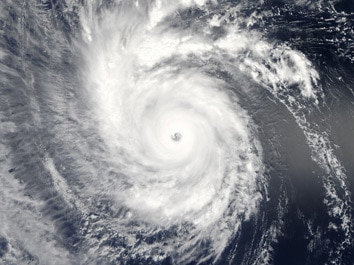Create a free profile to get unlimited access to exclusive videos, sweepstakes, and more!
Super Typhoon Maysak Seen From Space

On Tuesday, in the western Pacific Ocean, the tropical cyclone Maysak strengthened rapidly and became what is called a Super Typhoon, with sustained winds of more than 250 kilometers per hour, the equivalent of a Category 5 hurricane in the Atlantic. The main part of the storm has grown to a staggering 1,300 kilometers across and is headed for the Philippines.
High level winds are strong, and the wind shear may weaken the storm soon (winds blowing over the storm rob it of strength it needs to sustain itself). Still, the damage this immense typhoon can do is terrifying.
And yet, its beauty cannot be denied. Images taken by astronauts Terry Virts and Samantha Cristoforetti from the International Space Station are as surpassingly beautiful as they are quietly menacing.
From several hundred kilometers to the side and at an oblique angle, the entire storm can be seen. The feeder bands resemble the arms of a spiral galaxy, and you can see convective thunderstorm clouds popping up along them.
From a different angle with low Sun, radial streamers are visible outside the storm.
This image is looking down into the eye when the Sun was relatively low. Virts said, “It seemed like a black hole.” A space station solar panel can be seen on the left.
In another close shot, the feeder bands can be followed all the way in to the eye.
The full fury of the typhoon is apparent in this image taken by NASA’s Earth-observing Aqua satellite photo, taken on Tuesday. The detail in the high-resolution image is incredible.
According to Jeff Masters at Wunderground (via the Washington Post), this typhoon season has had a record early start, and Maysak is so strong due to unusually warm waters in the Pacific (due to a weak El Niño). I’ll note that global warming plays a part in warming waters as well, and while the interaction is complex, record-breaking typhoons and hurricanes may be more common now than they once were.
NASA’s efforts to study storms like this are critical in understanding them. How they form, grow, strengthen, and travel—this is obviously a life-or-death situation, and NASA’s fleet of Earth-observing satellites are helping meteorologists be able to predict them better. I strongly support NASA in this regard, as should any reasonable person.


























